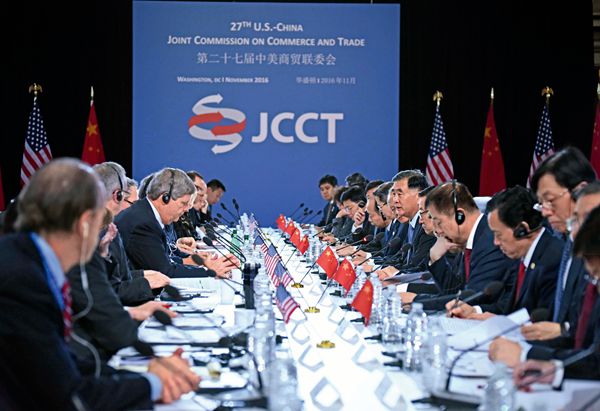New Model of Major-Country Relations to Enhance Joint Sino-U.S. Development
China Today by CHENG HONGLIANG, January 22, 2017 Adjust font size:
THE relationship between China and the U.S. is more complicated than that of any other two nations, and most influential in shaping the global situation. Although contention arose between the two powers last year over the South China Sea issue, they were able to handle the dispute amicably. It is notable that bilateral and multilateral cooperation has been steadily promoted through the fundamental mechanism of high-level meetings, such as summits of heads of state and the China-U.S. Strategic and Economic Dialogue (S&ED). Bilateral ties continue to advance, despite uncertainties triggered by the result of the 2016 U.S. presidential election, the ramifications of which are more intricate and profound than any election in recent decades.
The momentum of last year’s bilateral ties revealed further progress in building a new type of major-country relations, characterized by zero conflict, zero confrontation, mutual respect, and win-win cooperation.
During their meeting at the Annenberg Estate, California, in June 2013, Chinese President Xi Jinping and U.S. President Barack Obama agreed on the importance of understanding one another’s strategic objectives. The two heads of state undertook to be friends rather than rivals, to settle disagreements and disputes through dialogue and cooperation; to mutually respect one another’s social systems, development modes, core benefits, and major concerns; and to seek common ground by shelving differences and advancing towards inclusiveness.

The 27th U.S.-China Joint Commission on Commerce and Trade – one of the earliest economic and trade dialogue mechanisms – was held in Washington D.C. on November 23, 2016.
The old zero-sum game mindset must now give way to a new win-win approach to cooperation, wherein others’ interests are accommodated through the pursuit of one’s own. The world’s top two economies have patently different political systems, social ideology, history, and culture, and are at different stages of development. Yet China and the U.S. can nonetheless overcome these differences as they continue to advance towards a peaceful coexistence and common development to build a new type of major-country relationship. The progress achieved in 2016 has proven the feasibility of this goal.
Contentions and Disputes
The contention between China and the U.S. over certain sensitive issues have not affected the solid foundation of bilateral relations, thanks to both sides’ proactive management of disputes.
Last July saw a decision by the Arbitral Tribunal following the Philippines’ unilateral initiation of arbitration over its disputes with China in the South China Sea. During that period, the U.S. conducted joint navy drills in the region, joined with other countries in criticizing China, and issued statements that supported the Philippines. The aim was to exert pressure on China and form a fait juridique that would set an “example” to other parties involved in the dispute.
China retaliated in the civil and military sense, in the former case by launching intensive diplomatic activities that generated expressions of positive international public opinion in China’s favor and support from various countries and international organizations. Certain ASEAN member states spoke out, motivated by a sense of justice, and the Association as a whole intimated that it would not issue a joint statement in support of the result of the arbitration, from which the UN also distanced itself. In the latter, military sense, the PLA embarked on military exercises in the disputed waters, so displaying China’s resolve to safeguard its sovereignty and legitimate interests.
As concern grew throughout the international community that conflict might break out between China and the U.S. over this issue, the two powers made strong diplomatic endeavors to ease tensions and so assuage the situation. The U.S. Secretary of State, John Kerry, stated that the U.S. did not take any position on the result of the arbitration, and called on China and the Philippines to address the issue via dialogue and negotiation.
China and the U.S. indeed took proactive measures to manage their disputes before the arbitration award was issued. The two sides exchanged views through various channels, official and otherwise. For instance, former State Councilor Dai Bingguo articulated last July, at the China-U.S. Dialogue on South China Sea between Chinese and U.S. think tanks, China’s consistent position on the issue. Meanwhile, American strategists began taking account of the negative influence of the U.S.’s South China Sea policy on bilateral ties. Such interactions effectively cooled the dispute, inhibiting the issue’s impediment to bilateral relations.